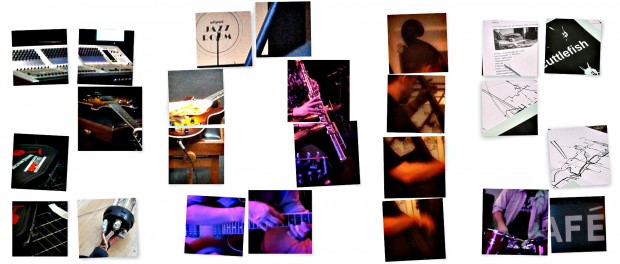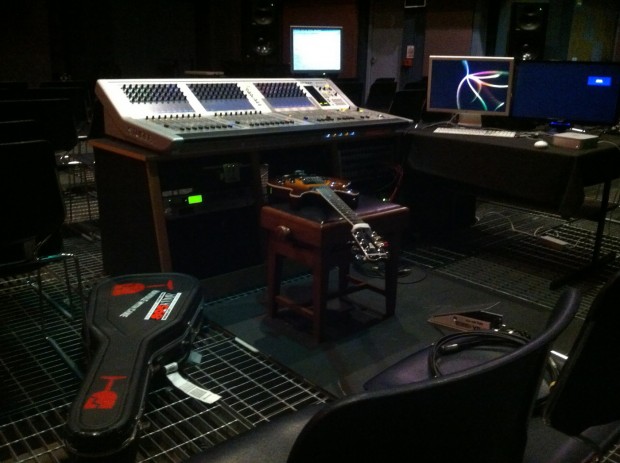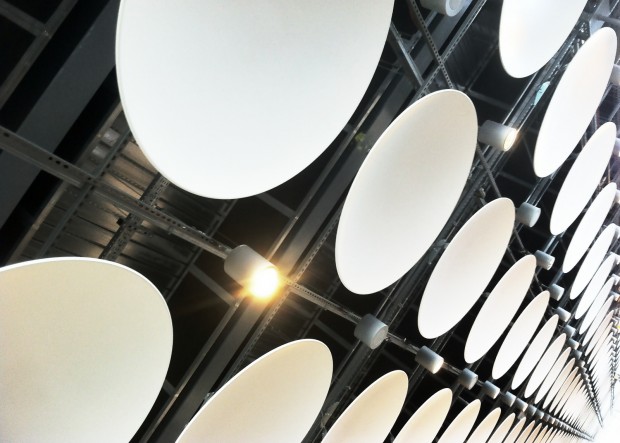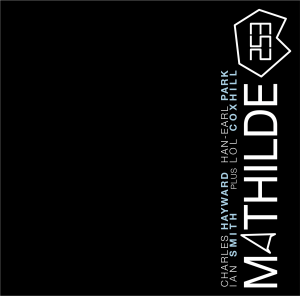
Happy New Year: 2015



Quick thanks for all involved in the seminar/performance at the Sonic Arts Research Center earlier this month. My hat goes off to all the administrative and technical folk: Chris Corrigan, Pearl Young, Marian Hanna, and, especially, Craig Jackson (who got the A/V up and running for the presentation). Kudos also to Miguel Angel Ortiz Pérez for acting as host when Justin was busy with other business.
Finally, big thanks to Caroline Pugh for the noise, out of the box choices, the occasional melody, and the momentary glimpse of semantics, and to Justin Yang for sharing the stage, and for inviting me in the first place.
Next up: performances coming on April 2 with Mike Pride and Catherine Sikora at Spectrum, New York. See the performance diary for up-to-date info.
 Tomorrow (Thursday, March 13, 2014) at 1:10pm: a performance by Han-earl Park (guitar) with Justin Yang (saxophones) and Caroline Pugh (voice) takes place at the Sonic Lab, (Sonic Arts Research Center, Queen’s University, Belfast, N. Ireland) [map…]. Free admission. Here’s the program:
Tomorrow (Thursday, March 13, 2014) at 1:10pm: a performance by Han-earl Park (guitar) with Justin Yang (saxophones) and Caroline Pugh (voice) takes place at the Sonic Lab, (Sonic Arts Research Center, Queen’s University, Belfast, N. Ireland) [map…]. Free admission. Here’s the program:

And at 1:00pm today (Wednesday, 12 March), Han-earl Park will be giving a seminar presentation at the Sonic Lab.

Thursday, March 13, 2014, at 1:10pm: a performance by Han-earl Park (guitar) with Justin Yang (saxophones) and Caroline Pugh (voice) takes place at the Sonic Lab, (Sonic Arts Research Center, Queen’s University, Belfast, N. Ireland) [map…]. Free admission.
Han-earl Park will also be giving a seminar presentation on the previous day (Wednesday, 12 March), 1:00pm at the Sonic Lab.
See the performance diary for up-to-date info. [SARC page…] [Program (PDF)…]
| date | venue | time | details |
|---|---|---|---|
| March 13, 2014 | Sonic Arts Research Center Queen’s University Belfast, N. Ireland |
1:10pm | Performance by Han-earl Park (guitar) with Justin Yang (saxophones) and Caroline Pugh (voice). Han-earl Park will also be giving a seminar presentation on the previous day (Wednesday, 12 March), 1:00pm at the Sonic Lab. Free admission. [Details…] [SARC page…] [Program (PDF)…] |
| April 2, 2014 | Spectrum 121 Ludlow Street Floor 2 (ring bell for 2) New York, NY 10002 |
9:30pm | Performance by Han-earl Park (guitar), Mike Pride (drums) and Catherine Sikora (saxophones). $15 ($10 students and seniors). [Details…] |
| 2014– | Europe | I am based in Europe as of 2014, and I am seeking performance opportunities for, in particular, my Europe-based projects including Numbers (with Richard Barrett), Mathilde 253 (with Charles Hayward and Ian Smith). Interested promoters, venues and sponsors, please get in touch! |
| September–October 2014 | Europe | Eris 136199 (Nick Didkovsky, Han-earl Park and Catherine Sikora) is seeking performance opportunities late-September and October 2014. Interested promoters, venues and sponsors, please get in touch! |
Continue reading “performance diary 01-22-14 (Belfast, New York)”
Thanks to the efforts of the Downtown documentarists—Don Mount, Kevin Reilly and Scott Friedlander—there’s been a lot of changes to my YouTube channel and playlists since my last announcement almost a year ago. In terms of project specific playlists, I’ve updated the Eris 136199 playlist [watch…], and created one for Metis 9 [watch…]

Just a summary of the updates that have been accumulating in my scrapbook since the last overhaul. Here’s some of the more recent additions. Enjoy! All music and audio recordings © + ℗ their respective owners.
Eris 136199 (Nick Didkovsky: guitar; Han-earl Park: guitar; and Catherine Sikora: saxophones).
Numbers: Richard Barrett (electronics) and Han-earl Park (guitar).
Ingrid Laubrock (saxophone) and Han-earl Park (guitar).
Han-earl Park (guitar), Catherine Sikora (saxophones) and Josh Sinton (clarinet and saxophone).
Michael Evans (drums), Louise Dam Eckardt Jensen (saxophone and flute) and Han-earl Park (guitar).
Mark Trayle (electronics), Gascia Ouzounian (violin), Chris Brown (piano), Paul Stapleton (percussion), Dan Goren (trumpet), Don Nichols (percussion), Simon Rose (saxophone), Gustavo Aguilar (percussion), Han-earl Park (guitar), Ulrich Mitzlaff (’cello), Tasos Stamou (zither), Dominic Lash (double bass), Christopher Williams (double bass), Nuno Rebelo (guitar), Richard Scott (synthesizer), Steven Davis (drums), Pedro Rebelo (piano), Justin Yang (saxophone) and Franziska Schroeder (saxophones).
Pedro Rebelo has just posted a video of ‘Call them Improvisors!,’ an Evan Parker-led ensemble performance that took place at the Sonic Arts Research Center, Belfast, November 7, 2010 [details…] [Sonorities page…].
The performers were Mark Trayle (electronics), Gascia Ouzounian (violin), Chris Brown (piano), Paul Stapleton (percussion), Dan Goren (trumpet), Don Nichols (percussion), Simon Rose (saxophone), Gustavo Aguilar (drums), Han-earl Park (guitar), Ulrich Mitzlaff (’cello), Tasos Stamou (zither), Dominic Lash (double bass), Christopher Williams (double bass), Nuno Rebelo (guitar), Richard Scott (synthesizer), Steven Davis (drums), Pedro Rebelo (piano), Justin Yang (saxophone) and Franziska Schroeder (saxophone). Shortly after the performance, I wrote:
Thanks in to the members of my local trio (as Richard pointed out, it’s very hard not to feel the pull of tribalism), Ulrich Mitzlaff and Gascia Ouzounian; to the emergent section leader of the neighboring trio Pedro Rebelo (with whom, during the rehearsal/trial run, I would share looks when things (creatively) self-destructed); to the Simon Rose-Dan Goren-Paul Stapleton unit which, in the best possible sense, seemed to have an agenda entirely their own; to the two bass players, Dom Lash and Christopher Williams, who entertained my left ear; to the remarkable drummers, Gustavo Aguilar and Steve Davis, who always knew, better than the rest of us put together, how to push/pull such a large ensemble during free play; to Franziska Schroeder for soaring over the group; Chris Brown for the asymmetrical hocket between Pedro, Justin and myself; to the electro-dudes, Mark Trayle and Richard Scott, who always sounded like themselves (especially the bass sample, Richard) and who generously gave visual/physical cues in relation to their performance; to the other guitarist, Nuno Rebelo, who artfully avoided collisions—I think we played well together, even if we rarely played at the same time; and to Justin Yang for creating, with Gustavo, that all too brief Shepp/Sanders moment—a moment of ascension—that helped to remind me what this was all about.
And of course, thanks to Pedro, Steve and Franziska for hosting, organizing and inviting, and to Evan Parker for taking time to guide us and the music.
I feel privileged to have been part of a large ensemble of improvisers of that caliber… and to have, through necessity and accident, found myself seated in the ideal position on stage (right in the middle—between the two pianos, the two drummers). I’m still thinking through the implications of tactics within such a context (especially in open improvisation), and am itching to do it again. [Original article…]
One for the Scrapbook…
As part of the general house keeping duties, I’ve updated the playlists at my YouTube channel. The ‘Han-earl Park’ playlist, at this time, features performances with Sean Ali, Chris Chafe, Chris Corrigan, Nick Didkovsky, Andrew Drury, Paul Dunmall, Michael Evans, Jonathan Goldberger, Louise Dam Eckardt Jensen, Will McEvoy, Manuela Meier, Jonathan Moritz, Pauline Oliveros, Gascia Ouzounian, Pedro Rebelo, Bradford Reed, Mark Sanders, Franziska Schroeder, Catherine Sikora, Jamie Smith, Doug Van Nort, Ben Wright, Jack Wright and Justin Yang, and videography by Don Mount, Kevin Reilly and John Hough.
And Eris 136199 now has its own playlist.

Originally posted at Stet Lab [original article…]:
As previously announced, after thirty-two events over three and a quarter years, I’ve stepped down as curator of Stet Lab as of February 2011. The duties of running the Lab now are in the very capable hands of Veronica Tadman, Tony O’Connor, Athos Tsiopani with curatorial duties handled by Kevin Terry (Kevin and Tony performed at the very first Lab!). I’d like to thank all of them, Kevin, Veronica and Eoin Callery in particular, for their work keeping this no-budget, alternatively pedagogical space on track over the years. (And thanks for the whisky y’all!—sorry I was too taken to make a proper speech.)
My thanks also to all the guest artists who have shared the stage with us, generously contributing to, and transforming, this practice. There’s too many names to mention, but I’d like to thank, in particular, two club-runners, Bruce Coates (who with Sarah O’Halloran and I kicked-off Stet Lab in November ’07) and Mike Hurley for their advice, cautionary tales and encouragement; to Murray Campbell, Franziska Schroeder and John Godfrey who took time out of their busy schedules, and stepped-up when others would/could not; and to Corey Mwamba, Ian Smith, Justin Yang and Alex Hawkins for encouraging words, and an unwavering belief in grass-roots music organizations. Special thanks to Paul Dunmall, Mark Sanders and Don Malone; heavy-hitters who believed in the Lab enough to participate with neophyte improvisers in what must be, by their standards, a low-key event.
Kudos to Jesse Ronneau for supporting improvised music, and the aims of the Lab in particular, during his time in Cork. I apologize for the many whose name I’ve not listed, but y’all have my warmest thanks, and my sincerest admiration for your contributions—we are a better space for it!
Of course, the biggest thanks go to everyone who participated as listener (and I am thinking in particular of the regulars who come every month!), and to those brave ones who jump-in the deep-end!
Signing-off as curator: Thanks, thanks, thanks and thanks to y’all!
BTW, some of my observations about running this space around the half-way point of my tenure as curator are at ‘Lab report 2007-2009: how to run an improvised music club’.
Please note that Stet Lab’s site has moved to stetlab.wordpress.com. Please update your bookmarks for the site and the corresponding web feeds. busterandfriends.com/stet will remain as an archive of Lab activities between November 2007 and April 2011.
Also, there is now an index of Lab reports written between June 2008 and April 2011 by fourteen author-practitioners documented over nineteen events from the POV of the stage.

First set of reviews of Mathilde 253 (SLAMCD 528) including a very nice piece from Guillaume Belhomme:
La mise en place inquiète (Hayward au mélodica) donnait quelques indices sur la teneur de l’entière improvisation : réfléchie, et dans laquelle les intervenants rivalisent de subtilités (Park érodant les reliefs de plaintes aux volumes variés, Smith au bugle saisissant). Passée la période de flottement ravissant—de vacance, presque, pour Hayward—,il faudra bien revenir aux turbulences afin de s’y montrer autrement convaincant. Alors, Coxhill peut apparaître : le soprano élabore des parallèles aux phrases du cuivre dublinois ; ourdit et trame, enfin tisse, sur le métier remonté crescendo par Hayward, une tapisserie de choix : celle d’une autre Mathilde, à la beauté tout roturière. [Read the rest…]
— Guillaume Belhomme (Le son du grisli)
Translation by Justin Yang:
The tentative opening (Hayward on melodica) gives some indication of the tenor of the entire improvisation: reflective, in which the stakeholders compete in subtilities (Park eroding reliefs of wailing in varied volumes, Smith with a seizing bugle). Passing through a section of ravishing suspension—of near absence for Hayward—,it becomes necessary to return to turbulence to remain convincing. Alas, Coxhill can appear: the soprano elaborates parallell reflections in phrases of Dublin brass; ordered and entwining, weaves on the crescendo where Hayward restablishes his presence, a tapestry of choice: that of another Mathilde, of a complete beauty.
More reviews…
Une session très sympa d’un trio relevé: Charles Hayward, Han-Earl Park et Ian Smith, plus Lol Coxhill comme invité sur deux des sept pièces. De l’improvisation libre soutenue, vive comme c’est souvent le cas avec Hayward à la batterie. [Read the rest…]
— François Couture (Monsieur Délire)
La genialità non è qualcosa che si trova per strada, ma a quanto pare in qualche studio di registrazione qualcosa di positivo si riesce a raggiungere. Il batterista avant rock Charles Hayward (fondatore del gruppoThis Heatha deciso di confrontarsi con musicisti provenienti da tutt´altre aree musicali, Han-earl Park, anche lui abituato al geneere noise e il trombettista Ian Smith, una delle icone dell´improvvisazione radicale inglese e parte della London Improvisers´ Orchestra. Insieme a loro sugli ultimi due brani si aggiunge un´altro famoso personaggio dell´avanguardia, il sassofonista soprano Lol Coxhill.
L´interazione fra i tre (e poi in quartetto) procede perfettamente buttando nel calderone un pò di tutto, in situazioni che avevamo ascoltate da unFred Frith, ma qui procede tutto in modo più logico, forse per la forza propulsiva del trombettista che si ritaglia degli spazi precisi, evitando che si scivoli troppo verso il genere noise.
Lol Coxhillnei brani finali (più di venti minuti di improvvisazione a tutto spiano) contribuisce ad animare la compagnia, evitando che scenda la tensione. Sono nell´insieme quasi settantacinque minuti di musica che scorrono veloci, in cui le idee arrivano subito ed di musicisti si divertono a metterle in pratica.
Album così non si producono certo in serie, per cui ben venga l´intuizione diGeorge Haslamdi pubblicarli: un altra cosa notevole nel suo catalogo.
— Cosimo Parisi (MusicBoom.it)
Как можно догадаться, музыка Mathilde 253 — свободная импровизация, в которой джазовая идиома превалирует, но которая до собственно джаза, даже в самом свободном его понимании, не доходит. …Хейуорд же своими барабанами, тяжелыми, находящимися будто в стороне от самой музыки, не пытающимися ни поспеть за ней, ни задать ей ход, дает импровизациям Mathilde 253 третье измерение. Он поразительно точно для человека, который большую часть жизни играл музыку неимпровизированную, слышит своих коллег, дает им пространство для жизни и никогда не перетягивает одеяло на себя — но именно его-то слушать отдельное удовольствие. [Read the rest…]
As one might guess, Mathilde 253’s music is free improvisation, in which the jazz idiom predominates, but which does not attain to jazz proper even in the freest understanding of the term. …It is Hayward with his drums, heavy and as it were standing aside from the music itself, not attempting either to keep up with it or to set its pace, who gives Mathilde 253’s improvisations a third dimension. With an accuracy remarkable in one who for much of his life played non-improvised music, he listens to his colleagues, gives them space to live and never steals the limelight—but he it is whom it is a particular pleasure to hear.
— Opium Mass, translation by Leofranc Holford-Strevens.
Mathilde 253’s eponymous debut CD (SLAMCD 528) available on SLAM Productions. [More info…] [All reviews…] [Get the CD…]
Thanks in to the members of my local trio (as Richard pointed out, it’s very hard not to feel the pull of tribalism), Ulrich Mitzlaff and Gascia Ouzounian; to the emergent section leader of the neighboring trio Pedro Rebelo (with whom, during the rehearsal/trial run, I would share looks when things (creatively) self-destructed); to the Simon Rose-Dan Goren-Paul Stapleton unit which, in the best possible sense, seemed to have an agenda entirely their own; to the two bass players, Dom Lash and Christopher Williams, who entertained my left ear; to the remarkable drummers, Gustavo Aguilar and Steve Davis, who always knew, better than the rest of us put together, how to push/pull such a large ensemble during free play; to Franziska Schroeder for soaring over the group; Chris Brown for the asymmetrical hocket between Pedro, Justin and myself; to the electro-dudes, Mark Trayle and Richard Scott, who always sounded like themselves (especially the bass sample, Richard) and who generously gave visual/physical cues in relation to their performance; to the other guitarist, Nuno Rebelo, who artfully avoided collisions—I think we played well together, even if we rarely played at the same time; and to Justin Yang for creating, with Gustavo, that all too brief Shepp/Sanders moment—a moment of ascension—that helped to remind me what this was all about.
And of course, thanks to Pedro, Steve and Franziska for hosting, organizing and inviting, and to Evan Parker for taking time to guide us and the music.
I feel privileged to have been part of a large ensemble of improvisers of that caliber… and to have, through necessity and accident, found myself seated in the ideal position on stage (right in the middle—between the two pianos, the two drummers). I’m still thinking through the implications of tactics within such a context (especially in open improvisation), and am itching to do it again.